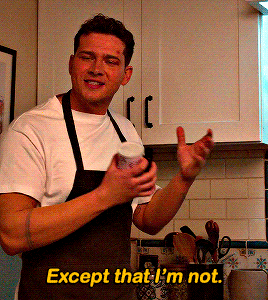Writer, Visionary. I'm a artist and I'm sensitive about my sh*t!
Don't wanna be here? Send us removal request.
Text

Writing with Color: Description Guide - Words for Skin Tone
We discussed the issue of describing People of Color by means of food in Part I of this guide, which brought rise to even more questions, mostly along the lines of “So, if food’s not an option, what can I use?” Well, I was just getting to that!
This final portion focuses on describing skin tone, with photo and passage examples provided throughout. I hope to cover everything from the use of straight-forward description to the more creatively-inclined, keeping in mind the questions we’ve received on this topic.
So let’s get to it.
S T A N D A R D D E S C R I P T I O N
B a s i c C o l o r s

Pictured above: Black, Brown, Beige, White, Pink.
“She had brown skin.”
This is a perfectly fine description that, while not providing the most detail, works well and will never become cliché.
Describing characters’ skin as simply brown or beige works on its own, though it’s not particularly telling just from the range in brown alone.
C o m p l e x C o l o r s
These are more rarely used words that actually “mean” their color. Some of these have multiple meanings, so you’ll want to look into those to determine what other associations a word might have.

Pictured above: Umber, Sepia, Ochre, Russet, Terra-cotta, Gold, Tawny, Taupe, Khaki, Fawn.
Complex colors work well alone, though often pair well with a basic color in regards to narrowing down shade/tone.
For example: Golden brown, russet brown, tawny beige…
As some of these are on the “rare” side, sliding in a definition of the word within the sentence itself may help readers who are unfamiliar with the term visualize the color without seeking a dictionary.
“He was tall and slim, his skin a russet, reddish-brown.”
Comparisons to familiar colors or visuals are also helpful:
“His skin was an ochre color, much like the mellow-brown light that bathed the forest.”
M o d i f i e r s
Modifiers, often adjectives, make partial changes to a word.The following words are descriptors in reference to skin tone.
D a r k - D e e p - R i c h - C o o l
W a r m - M e d i u m - T a n
F a i r - L i g h t - P a l e
Rich Black, Dark brown, Warm beige, Pale pink…
If you’re looking to get more specific than “brown,” modifiers narrow down shade further.
Keep in mind that these modifiers are not exactly colors.
As an already brown-skinned person, I get tan from a lot of sun and resultingly become a darker, deeper brown. I turn a pale, more yellow-brown in the winter.
While best used in combination with a color, I suppose words like “tan” “fair” and “light” do work alone; I’d just note that tan is less likely to be taken for “naturally tan” and much more likely a tanned white person.
Calling someone “dark” as description on its own is offensive to some and also ambiguous. (See: Describing Skin as Dark)
U n d e r t o n e s
Undertones are the colors beneath the skin, seeing as skin isn’t just one even color but has more subdued tones within the dominating palette.

Mentioning the undertones within a character’s skin is an even more precise way to denote skin tone.
As shown, there’s a difference between say, brown skin with warm orange-red undertones (Kelly Rowland) and brown skin with cool, jewel undertones (Rutina Wesley).
“A dazzling smile revealed the bronze glow at her cheeks.”
“He always looked as if he’d ran a mile, a constant tinge of pink under his tawny skin.”
Standard Description Passage
“Farah’s skin, always fawn, had burned and freckled under the summer’s sun. Even at the cusp of autumn, an uneven tan clung to her skin like burrs. So unlike the smooth, red-brown ochre of her mother, which the sun had richened to a blessing.”
-From my story “Where Summer Ends” featured in Strange Little Girls
Here the state of skin also gives insight on character.
Note my use of “fawn” in regards to multiple meaning and association. While fawn is a color, it’s also a small, timid deer, which describes this very traumatized character of mine perfectly.
Though I use standard descriptions of skin tone more in my writing, at the same time I’m no stranger to creative descriptions, and do enjoy the occasional artsy detail of a character.
C R E A T I V E D E S C R I P T I O N
Whether compared to night-cast rivers or day’s first light…I actually enjoy seeing Characters of Colors dressed in artful detail.
I’ve read loads of descriptions in my day of white characters and their “smooth rose-tinged ivory skin”, while the PoC, if there, are reduced to something from a candy bowl or a Starbucks drink, so to actually read of PoC described in lavish detail can be somewhat of a treat.
Still, be mindful when you get creative with your character descriptions. Too many frills can become purple-prose-like, so do what feels right for your writing when and where. Not every character or scene warrants a creative description, either. Especially if they’re not even a secondary character.
Using a combination of color descriptions from standard to creative is probably a better method than straight-up creative. But again, do what’s good for your tale.
N A T U R AL S E T T I N G S - S K Y

Pictured above: Harvest Moon -Twilight, Fall/Autumn Leaves, Clay, Desert/Sahara, Sunlight - Sunrise - Sunset - Afterglow - Dawn- Day- Daybreak, Field - Prairie - Wheat, Mountain/Cliff, Beach/Sand/Straw/Hay.
Now before you run off to compare your heroine’s skin to the harvest moon or a cliff side, think about the associations to your words.
When I think cliff, I think of jagged, perilous, rough. I hear sand and picture grainy, yet smooth. Calm. mellow.
So consider your character and what you see fit to compare them to.
Also consider whose perspective you’re describing them from. Someone describing a person they revere or admire may have a more pleasant, loftier description than someone who can’t stand said person.
“Her face was like the fire-gold glow of dawn, lifting my gaze, drawing me in.”
“She had a sandy complexion, smooth and tawny.”
Even creative descriptions tend to draw help from your standard words.
F L O W E R S

Pictured above: Calla lilies, Western Coneflower, Hazel Fay, Hibiscus, Freesia, Rose
It was a bit difficult to find flowers to my liking that didn’t have a 20 character name or wasn’t called something like “chocolate silk” so these are the finalists.
You’ll definitely want to avoid purple-prose here.
Also be aware of flowers that most might’ve never heard of. Roses are easy, as most know the look and coloring(s) of this plant. But Western coneflowers? Calla lilies? Maybe not so much.
“He entered the cottage in a huff, cheeks a blushing brown like the flowers Nana planted right under my window. Hazel Fay she called them, was it?”
A S S O R T E D P L A N T S & N A T U R E

Pictured above: Cattails, Seashell, Driftwood, Pinecone, Acorn, Amber
These ones are kinda odd. Perhaps because I’ve never seen these in comparison to skin tone, With the exception of amber.
At least they’re common enough that most may have an idea what you’re talking about at the mention of “pinecone.“
I suggest reading out your sentences aloud to get a better feel of how it’ll sounds.
“Auburn hair swept past pointed ears, set around a face like an acorn both in shape and shade.”
I pictured some tree-dwelling being or person from a fantasy world in this example, which makes the comparison more appropriate.
I don’t suggest using a comparison just “’cuz you can” but actually being thoughtful about what you’re comparing your character to and how it applies to your character and/or setting.
W O O D

Pictured above: Mahogany, Walnut, Chestnut, Golden Oak, Ash
Wood is definitely an iffy description for skin tone. Not only due to several of them having “foody” terminology within their names, but again, associations.
Some people would prefer not to compare/be compared to wood at all, so get opinions, try it aloud, and make sure it’s appropriate to the character if you do use it.
“The old warlock’s skin was a deep shade of mahogany, his stare serious and firm as it held mine.”
M E T A L S

Pictured above: Platinum, Copper, Brass, Gold, Bronze
Copper skin, brass-colored skin, golden skin…
I’ve even heard variations of these used before by comparison to an object of the same properties/coloring, such as penny for copper.
These also work well with modifiers.
“The dress of fine white silks popped against the deep bronze of her skin.”
G E M S T O N E S - M I N E R A LS

Pictured above: Onyx, Obsidian, Sard, Topaz, Carnelian, Smoky Quartz, Rutile, Pyrite, Citrine, Gypsum
These are trickier to use. As with some complex colors, the writer will have to get us to understand what most of these look like.
If you use these, or any more rare description, consider if it actually “fits” the book or scene.
Even if you’re able to get us to picture what “rutile” looks like, why are you using this description as opposed to something else? Have that answer for yourself.
“His skin reminded her of the topaz ring her father wore at his finger, a gleaming stone of brown, mellow facades.”
P H Y S I C A L D E S C R I P T I ON
Physical character description can be more than skin tone.
Show us hair, eyes, noses, mouth, hands…body posture, body shape, skin texture… though not necessarily all of those nor at once.
Describing features also helps indicate race, especially if your character has some traits common within the race they are, such as Afro hair to a Black character.
How comprehensive you decide to get is up to you. I wouldn’t overdo it and get specific to every mole and birthmark. Noting defining characteristics is good, though, like slightly spaced front teeth, curls that stay flopping in their face, hands freckled with sunspots…
G E N E R A L T I P S
Indicate Race Early: I suggest indicators of race be made at the earliest convenience within the writing, with more hints threaded throughout here and there.
Get Creative All On Your Own: Obviously, I couldn’t cover every proper color or comparison in which has been “approved” to use for your characters’ skin color, so it’s up to you to use discretion when seeking other ways and shades to describe skin tone.
Skin Color May Not Be Enough: Describing skin tone isn’t always enough to indicate someone’s ethnicity. As timeless cases with readers equating brown to “dark white” or something, more indicators of race may be needed.
Describe White characters and PoC Alike: You should describe the race and/or skin tone of your White characters just as you do your Characters of Color. If you don’t, you risk implying that White is the default human being and PoC are the “Other”).
PSA: Don’t use “Colored.” Based on some asks we’ve received using this word, I’d like to say that unless you or your character is a racist grandmama from the 1960s, do not call People of Color “colored” please.
Not Sure Where to Start? You really can’t go wrong using basic colors for your skin descriptions. It’s actually what many people prefer and works best for most writing. Personally, I tend to describe my characters using a combo of basic colors + modifiers, with mentions of undertones at times. I do like to veer into more creative descriptions on occasion.
Want some alternatives to “skin” or “skin color”? Try: Appearance, blend, blush, cast, coloring, complexion, flush, glow, hue, overtone, palette, pigmentation, rinse, shade, sheen, spectrum, tinge, tint, tone, undertone, value, wash.
Skin Tone Resources
List of Color Names
The Color Thesaurus
Things that are Brown (blog)
Skin Undertone & Color Matching
Tips and Words on Describing Skin
Photos: Undertones Described (Modifiers included)
Online Thesaurus (try colors, such as “red” & “brown”)
Don’t Call me Pastries: Creative Skin Tones w/ pics 3 2 1
Writing & Description Guides
WWC Guide: Words to Describe Hair
Writing with Color: Description & Skin Color
Describing Characters of Color (Passage Examples)
7 Offensive Mistakes Well-intentioned Writers Make
I tried to be as comprehensive as possible with this guide, but if you have a question regarding describing skin color that hasn’t been answered within part I or II of this guide, or have more questions after reading this post, feel free to ask!
~ Mod Colette
170K notes
·
View notes
Text

by clicking the source link, you will find 26 gifs of mason gooding in his role as paul in the movie want you back (2022). all of the gifs were created by me from scratch. you absolutely may use these gifs to roleplay or as reaction gifs, but ask you to not use them in smut rps, nsfw content, or celebrity rping. i kindly ask you to not repost or claim these gifs as your own. let me know if you would like to edit these gifs for any purpose. like and reblog if using!
(click here for my other mason gooding gif packs)

182 notes
·
View notes
Text

by clicking the source link, you will find 60 gifs of mason gooding in his role as calvin riggins in the movie moonshot (2022). all of the gifs were created by me from scratch. you absolutely may use these gifs to roleplay or as reaction gifs, but ask you to not use them in smut rps, nsfw content, or celebrity rping. i kindly ask you to not repost or claim these gifs as your own. let me know if you would like to edit these gifs for any purpose. like and reblog if using!
(click here for my other mason gooding gif packs)

107 notes
·
View notes
Text
If you click HERE you’ll find 150 gifs of Mason Gooding from his role in Season 1 of Love Victor. He is of European, African-American, and African-Barbadian descent, so please cast accordingly. All gifs were made by me and are 268 x 160. You are welcome to resize these/edit for personal use, but do not redistribute or claim them as your own. Content warning: partial nudity, kissing, and flashing lights.



197 notes
·
View notes
Text

by clicking the source link, you will find 230 gifs of mason gooding in his role as andrew spencer in the series love victor (season 3). all of the gifs were created by me from scratch. you may use these gifs to roleplay or as reaction gifs, but ask you to not use them in smut rps, nsfw content, or celebrity rping. i kindly ask you to not repost or claim these gifs as your own. let me know if you would like to edit these gifs for any purpose. like and reblog if using!
tw: kissing, flashing lights, fire
(click here for my other mason gooding gif packs)

321 notes
·
View notes
Text
HERE you’ll find 140 Gifs of Mason Gooding from Scream (2022) & Scream VI (2023) All of these were made by me. If you use them, like them or whatever, like or reblog from this post. Please do not repost. Enjoy!


117 notes
·
View notes
Text
[ HERE ] you’ll find 222 gifs of the actor, Mason Gooding, from his role in the movie, Hearteyes (2025). I hope that these gifs can be useful to someone. You can find my rules here. Suffice it to say that I ask that the time I spent making these be respected and that the fc himself be respected. Please be aware that these gifs are from a war movie and so, have many triggers which include blood, injury, weapons, kissing, police, and flashing lights. If you found these gifs to be helpful, please like and/or reblog this post. If you’d like to, please consider donating to my ko-fi. Enjoy!



162 notes
·
View notes
Photo






LEAH JEFFRIES as Daisy Something from Tiffany’s (2022), dir. Daryl Wein
118 notes
·
View notes
Text










maddie's like: just be subtle 😇 don't push �� he'll get there 🙏 i hope 💀
2K notes
·
View notes
Text

Writing with Color: Description Guide - Words for Skin Tone
We discussed the issue of describing People of Color by means of food in Part I of this guide, which brought rise to even more questions, mostly along the lines of “So, if food’s not an option, what can I use?” Well, I was just getting to that!
This final portion focuses on describing skin tone, with photo and passage examples provided throughout. I hope to cover everything from the use of straight-forward description to the more creatively-inclined, keeping in mind the questions we’ve received on this topic.
So let’s get to it.
S T A N D A R D D E S C R I P T I O N
B a s i c C o l o r s

Pictured above: Black, Brown, Beige, White, Pink.
“She had brown skin.”
This is a perfectly fine description that, while not providing the most detail, works well and will never become cliché.
Describing characters’ skin as simply brown or beige works on its own, though it’s not particularly telling just from the range in brown alone.
C o m p l e x C o l o r s
These are more rarely used words that actually “mean” their color. Some of these have multiple meanings, so you’ll want to look into those to determine what other associations a word might have.

Pictured above: Umber, Sepia, Ochre, Russet, Terra-cotta, Gold, Tawny, Taupe, Khaki, Fawn.
Complex colors work well alone, though often pair well with a basic color in regards to narrowing down shade/tone.
For example: Golden brown, russet brown, tawny beige…
As some of these are on the “rare” side, sliding in a definition of the word within the sentence itself may help readers who are unfamiliar with the term visualize the color without seeking a dictionary.
“He was tall and slim, his skin a russet, reddish-brown.”
Comparisons to familiar colors or visuals are also helpful:
“His skin was an ochre color, much like the mellow-brown light that bathed the forest.”
M o d i f i e r s
Modifiers, often adjectives, make partial changes to a word.The following words are descriptors in reference to skin tone.
D a r k - D e e p - R i c h - C o o l
W a r m - M e d i u m - T a n
F a i r - L i g h t - P a l e
Rich Black, Dark brown, Warm beige, Pale pink…
If you’re looking to get more specific than “brown,” modifiers narrow down shade further.
Keep in mind that these modifiers are not exactly colors.
As an already brown-skinned person, I get tan from a lot of sun and resultingly become a darker, deeper brown. I turn a pale, more yellow-brown in the winter.
While best used in combination with a color, I suppose words like “tan” “fair” and “light” do work alone; I’d just note that tan is less likely to be taken for “naturally tan” and much more likely a tanned white person.
Calling someone “dark” as description on its own is offensive to some and also ambiguous. (See: Describing Skin as Dark)
U n d e r t o n e s
Undertones are the colors beneath the skin, seeing as skin isn’t just one even color but has more subdued tones within the dominating palette.

Mentioning the undertones within a character’s skin is an even more precise way to denote skin tone.
As shown, there’s a difference between say, brown skin with warm orange-red undertones (Kelly Rowland) and brown skin with cool, jewel undertones (Rutina Wesley).
“A dazzling smile revealed the bronze glow at her cheeks.”
“He always looked as if he’d ran a mile, a constant tinge of pink under his tawny skin.”
Standard Description Passage
“Farah’s skin, always fawn, had burned and freckled under the summer’s sun. Even at the cusp of autumn, an uneven tan clung to her skin like burrs. So unlike the smooth, red-brown ochre of her mother, which the sun had richened to a blessing.”
-From my story “Where Summer Ends” featured in Strange Little Girls
Here the state of skin also gives insight on character.
Note my use of “fawn” in regards to multiple meaning and association. While fawn is a color, it’s also a small, timid deer, which describes this very traumatized character of mine perfectly.
Though I use standard descriptions of skin tone more in my writing, at the same time I’m no stranger to creative descriptions, and do enjoy the occasional artsy detail of a character.
C R E A T I V E D E S C R I P T I O N
Whether compared to night-cast rivers or day’s first light…I actually enjoy seeing Characters of Colors dressed in artful detail.
I’ve read loads of descriptions in my day of white characters and their “smooth rose-tinged ivory skin”, while the PoC, if there, are reduced to something from a candy bowl or a Starbucks drink, so to actually read of PoC described in lavish detail can be somewhat of a treat.
Still, be mindful when you get creative with your character descriptions. Too many frills can become purple-prose-like, so do what feels right for your writing when and where. Not every character or scene warrants a creative description, either. Especially if they’re not even a secondary character.
Using a combination of color descriptions from standard to creative is probably a better method than straight-up creative. But again, do what’s good for your tale.
N A T U R AL S E T T I N G S - S K Y

Pictured above: Harvest Moon -Twilight, Fall/Autumn Leaves, Clay, Desert/Sahara, Sunlight - Sunrise - Sunset - Afterglow - Dawn- Day- Daybreak, Field - Prairie - Wheat, Mountain/Cliff, Beach/Sand/Straw/Hay.
Now before you run off to compare your heroine’s skin to the harvest moon or a cliff side, think about the associations to your words.
When I think cliff, I think of jagged, perilous, rough. I hear sand and picture grainy, yet smooth. Calm. mellow.
So consider your character and what you see fit to compare them to.
Also consider whose perspective you’re describing them from. Someone describing a person they revere or admire may have a more pleasant, loftier description than someone who can’t stand said person.
“Her face was like the fire-gold glow of dawn, lifting my gaze, drawing me in.”
“She had a sandy complexion, smooth and tawny.”
Even creative descriptions tend to draw help from your standard words.
F L O W E R S

Pictured above: Calla lilies, Western Coneflower, Hazel Fay, Hibiscus, Freesia, Rose
It was a bit difficult to find flowers to my liking that didn’t have a 20 character name or wasn’t called something like “chocolate silk” so these are the finalists.
You’ll definitely want to avoid purple-prose here.
Also be aware of flowers that most might’ve never heard of. Roses are easy, as most know the look and coloring(s) of this plant. But Western coneflowers? Calla lilies? Maybe not so much.
“He entered the cottage in a huff, cheeks a blushing brown like the flowers Nana planted right under my window. Hazel Fay she called them, was it?”
A S S O R T E D P L A N T S & N A T U R E

Pictured above: Cattails, Seashell, Driftwood, Pinecone, Acorn, Amber
These ones are kinda odd. Perhaps because I’ve never seen these in comparison to skin tone, With the exception of amber.
At least they’re common enough that most may have an idea what you’re talking about at the mention of “pinecone.“
I suggest reading out your sentences aloud to get a better feel of how it’ll sounds.
"Auburn hair swept past pointed ears, set around a face like an acorn both in shape and shade.”
I pictured some tree-dwelling being or person from a fantasy world in this example, which makes the comparison more appropriate.
I don’t suggest using a comparison just “’cuz you can” but actually being thoughtful about what you’re comparing your character to and how it applies to your character and/or setting.
W O O D

Pictured above: Mahogany, Walnut, Chestnut, Golden Oak, Ash
Wood is definitely an iffy description for skin tone. Not only due to several of them having “foody” terminology within their names, but again, associations.
Some people would prefer not to compare/be compared to wood at all, so get opinions, try it aloud, and make sure it’s appropriate to the character if you do use it.
“The old warlock’s skin was a deep shade of mahogany, his stare serious and firm as it held mine.”
M E T A L S

Pictured above: Platinum, Copper, Brass, Gold, Bronze
Copper skin, brass-colored skin, golden skin…
I’ve even heard variations of these used before by comparison to an object of the same properties/coloring, such as penny for copper.
These also work well with modifiers.
“The dress of fine white silks popped against the deep bronze of her skin.”
G E M S T O N E S - M I N E R A LS

Pictured above: Onyx, Obsidian, Sard, Topaz, Carnelian, Smoky Quartz, Rutile, Pyrite, Citrine, Gypsum
These are trickier to use. As with some complex colors, the writer will have to get us to understand what most of these look like.
If you use these, or any more rare description, consider if it actually “fits” the book or scene.
Even if you’re able to get us to picture what “rutile” looks like, why are you using this description as opposed to something else? Have that answer for yourself.
“His skin reminded her of the topaz ring her father wore at his finger, a gleaming stone of brown, mellow facades.”
P H Y S I C A L D E S C R I P T I ON
Physical character description can be more than skin tone.
Show us hair, eyes, noses, mouth, hands…body posture, body shape, skin texture… though not necessarily all of those nor at once.
Describing features also helps indicate race, especially if your character has some traits common within the race they are, such as Afro hair to a Black character.
How comprehensive you decide to get is up to you. I wouldn’t overdo it and get specific to every mole and birthmark. Noting defining characteristics is good, though, like slightly spaced front teeth, curls that stay flopping in their face, hands freckled with sunspots…
G E N E R A L T I P S
Indicate Race Early: I suggest indicators of race be made at the earliest convenience within the writing, with more hints threaded throughout here and there.
Get Creative All On Your Own: Obviously, I couldn’t cover every proper color or comparison in which has been “approved” to use for your characters’ skin color, so it’s up to you to use discretion when seeking other ways and shades to describe skin tone.
Skin Color May Not Be Enough: Describing skin tone isn’t always enough to indicate someone’s ethnicity. As timeless cases with readers equating brown to “dark white” or something, more indicators of race may be needed.
Describe White characters and PoC Alike: You should describe the race and/or skin tone of your White characters just as you do your Characters of Color. If you don’t, you risk implying that White is the default human being and PoC are the “Other”).
PSA: Don’t use “Colored.” Based on some asks we’ve received using this word, I’d like to say that unless you or your character is a racist grandmama from the 1960s, do not call People of Color “colored” please.
Not Sure Where to Start? You really can’t go wrong using basic colors for your skin descriptions. It’s actually what many people prefer and works best for most writing. Personally, I tend to describe my characters using a combo of basic colors + modifiers, with mentions of undertones at times. I do like to veer into more creative descriptions on occasion.
Want some alternatives to “skin” or “skin color”? Try: Appearance, blend, blush, cast, coloring, complexion, flush, glow, hue, overtone, palette, pigmentation, rinse, shade, sheen, spectrum, tinge, tint, tone, undertone, value, wash.
Skin Tone Resources
List of Color Names
The Color Thesaurus
Things that are Brown (blog)
Skin Undertone & Color Matching
Tips and Words on Describing Skin
Photos: Undertones Described (Modifiers included)
Online Thesaurus (try colors, such as “red” & “brown”)
Don’t Call me Pastries: Creative Skin Tones w/ pics 3 2 1
Writing & Description Guides
WWC Guide: Words to Describe Hair
Writing with Color: Description & Skin Color
Describing Characters of Color (Passage Examples)
7 Offensive Mistakes Well-intentioned Writers Make
I tried to be as comprehensive as possible with this guide, but if you have a question regarding describing skin color that hasn’t been answered within part I or II of this guide, or have more questions after reading this post, feel free to ask!
~ Mod Colette
170K notes
·
View notes
Text

Writing With Color Top Posts + Other Useful Ones
Oh hey– here’s a list ranked by Writing With Color’s most popular posts since opening in 2014 up till now, the start of 2017. Pulled together for the interest and usefulness for readers like you. Thank you.
Top 7 Popular Original Posts
Words for Skin Tone - This two part guide offers an array of words for describing skin color. Part I focuses on the problems with food descriptors. Part II provides alternatives. (68k+ Notes)
Common Micro-aggressions: African Americans and/or Black People - An extensive list of common micro-aggressions towards Black people with some links for further reading. (46k)
Words to Describe Hair - As with the words for skin tone, an offering of words to describe hair, from curls to different colors. (34k+)
Black and White Symbolism: A Look into the Trope - Discusses concept of black as evil and white as good, from its history & problem implications. Guide offers alternatives & solutions. (10k)
Describing Accents - An example-based post for describing accents and voices. (5k)
How to Research your Racially/Ethnically Diverse Characters - Self-explanatory. (5k)
Describing Asian Eyes - A guide to describing Asian eyes with further useful commentary. (4k)
Honorable Mentions
Other recommended WWC Posts.
The Key to Moving Beyond Checklisting is Not Less Diversity - “The problem with pasted-on diversity is not the diversity; it’s the pasted on part.”
Stereotyped vs Nuanced Characters and Audience Perception - Discusses one of our more common ask themes: the writing (or rather, the not writing) of stereotypes.
When We Read: Mod Wishlist - A list of what we as mods would like to see of ourselves in media. Check out the Native American WL too.
Bad Representation vs Tokenism vs Diversity just existing without justification like in the real world -Title says it all.
Stereotyping Tropes List - A categorized tropes list reposted from the TV Tropes website with links to their topics on the subject matter.
–WWC
13K notes
·
View notes
Text

Writing With Color – Featured Description Posts
Some of our most useful posts on describing People of Color, all in one place.
Words to Describe Hair
Words to Describe Skin Tone
Describing Asian Eyes
Describing Wide Noses
Describing Undead & Sick Dark Skin
Describing POC and Avoiding Caricatures
Describing Unnatural Skin Tones: Green
Describing Unnatural Skin Tones: Jaundice
Indicating Race of Characters (FAQ Questions #3-4)
Not Indicating Race at All – Note: You Probably Should
Praising Beauty Without Fetishizing
Describing Characters Without Othering
Olive Skin, Race and Ethnicity
Specific Description Posts
Describing Skin as Swarthy (Spoiler alert: it’s sketchy)
Describing East Asian Skin as Porcelain (Spoiler alert: it’s also sketchy)
Describing Skin as Russet (Spoiler alert: it’s alright)
Describing PoC as Exotic (SA: it’s othering)
Describing Skin as Ebony (SA: it’s cliche)
Describing Natural Hair as Cloud-Like (SA: it’s cool)
Describing Black Hair as Unkempt (SA: it’s offensive)
Describing Black Hair as Kinky (SA: it depends)
Describing Skin as “Dark as Night” (SA: it also depends)
Describing Skin as Like Dirt or Soil (SA: See above)
Describing Skin as just “Dark.” (SA: it’s vague)
Describing Black Hair as “Nappy” (SA: it ain’t recommended)
Describing Skin With Food (SA: it’s a no-no)
–WWC
48K notes
·
View notes
Text
WWC - General Topics

A collection of WWC posts that deal with more general writing advice, character creation and diversity topics applicable to most marginalized people, particularly People of Color and some more specific ethnic and religious groups.
Tools
Writing Research and Google Search Tips
WWC Research & Resources Guides (Compilation)
Character of Color Research Tracking Chart (Google Sheet)
Writing Characters of Color: The Generals
On White Authors “Getting it Right”
The Do’s of Writing People of Color
Writing POC with Little Experience
Properly Coded: Creating Characters of Color
On “Overthinking” Writing Characters of Color
On White Writers Writing Characters of Color (I, II, III)
Researching PoC + Supporting Writers of Color
Description
Words for Skin Tone
Words to Describe Hair
Describing Asian Eyes
Describing Wide Noses
Praising Beauty Without Fetishizing
Describing PoC and Avoiding Caricatures
Featured Description Guides (Compilation)
Diversity & Representation
To Write (or not write) with Diversity
So You Want To Save The World From Bad Representation
Diversity vs. Exploiting Cultures
Diversifying a Predominately-White Cast
On “Diversity Quotas”
On Excluding Diversity Out of Fear
Different Heritage POV’s in a Story
Including Realistic Diversity Naturally
White-Dominant Rural Areas and Diversity
White Privilege, Publishing, and Diversity Quotas
Writing: Making Efforts in Diversity
Characters - Creation & Culture
More on Assigning Race after Writing
Tradition and Culture vs. Stereotype
Showing Culture Writing Advice
Character Creation: Culture or Character first?
Character Design and Assigning Race and Ethnicity
Characters’ Races Added Last During Development
Determining your Characters’ Race and/or Ethnicity
Stereotyped vs Nuanced & Audience Perception
Writing Powerful Women of Multiple Races
Characters - Cultural Disconnect & Erasure
A Discussion on Culture and Erasure
Western Neutral Characters
‘Whitewashed’ Character of Color?
“Culturing” Culturally-disengaged PoC
Characters of Color with “No Culture”
Mixed Race + Disconnect from Culture
Reconnecting to Culture After Assimilation Attempts
Fantasy & Coding
Defining Coding (& Islam-coded Fantasy)
Denoting Race in Fantasy Setting
Fairy Tale Retellings with POC
Fairies of Color & Cultural Fairy Concepts
Fantasy Races Based off of People of Color
Naming People and Places, Avoiding Explicit Coding
Racially-coding Aliens
Real Religions in a Fantasy World
Religion in Fiction & Fantasy
South Asian-Coded Fantasy Caste System
Whitewashing in a Fantasy Setting
Including Racism in Fantasy
World-building: A Fantasy World without Racism
Representing PoC in Fantasy When Their Country/Continent Doesn’t Exist
Race Allegories / Symbolic Racism
Avoiding Racism Allegories
Blue eyed people enslaved in story
Half Human as Allegory for Mixed Race Struggles
Avoiding Half-Human Allegory for the “Mixed Race Experience”
Eye Color Discrimination as Racism: Story Concept
Racism, Micro-Aggressions & Slurs
Everyday Racism, Friendship and White Allies
Incorporating Micro-Aggressions in Writing
Racist Characters + Including Racism in Stories Not “About” Racism
The Pitfalls of Racist Character Redemption Arcs
PoC Educating White Privileged Friend (Context: Black Characters)
On “Normalizing” Protagonists of Color: Writing Stories Where Racism Isn’t in the Plot
Racial Slurs & Offensive Terms
Slur use in stories
Racial Slurs and Webcomics
Portraying Racist Characters without Racial Slurs
Offensive Terminology and Historical Accuracy
Stereotypes & Tropes
Stereotypes & Tropes Navigation
Stereotyped vs Nuanced Characters and Audience Perception
Useful Non-WWC Posts
When Diversity Is Bad by tropesaretools
Diversity Exists in the Real World by shiraglassman
How to Write WOC and MOC if you are White by kaylapocalypse
“I feel pressured to be inclusive in my writing!” by nimblesnotebook
On White Fear & Creating Diverse Transformative Works by saathi1013
Villains / Anti-heroes
Villains of Color
Family of Villains (Black)
Predominately White Villains
PoC Villains, Anti-Villains and Anti-Heroes
PoC in Crime Families & Black/Native Boss
Writing Flawed Black Characters is Okay
Dark and Light-skinned Characters, Black Villain and Avoiding Colorism
Worldbuilding
Black & White Symbolism: a look at that trope
Homogenization, Cultural Appropriation
How To Blend Cultures (Without Making Impossible Mixes)
Research:Large to Small Scale, Avoiding Homogenizing East Asian Cultures, & Paralleling Regions Appropriately
White Saviors, White - POC Interactions
Interracial Relationships: Romantic | Writing Interracial Friendships
How to Avoid Glorifying White Characters
Handling a White Female Savior in story
White Character Adopts Black Child in Apocalypse
White Villainous Cult Leader Uses Fascism to “Correct” Colonialism
How to write bigoted villains without coming off as a bigot yourself
Infantilization of white characters (At PoC’s expense)
Solving World Hunger: Changing Skin to Fantasy Color to Avoid the White Savior
Writing About Your Own Culture (Ownvoices)
Misrepresenting Your Own Culture
Why Insiders Can Write Their Experience
Writing Authentic Black Characters (as a Black writer)
Representing yourself in stories when “yourself” isn’t white
Braving Diversity: How to Write Yourself (and others) out of your Story
Building a Community for Fellow Sci-Fi/Fantasy [Black] Writers of Color
Writing Authentically From Your Own Experiences When They Don’t Match Stereotypes
Writing Sensitive & Controversial Topics
White Authors and Topics to Avoid/Tread Carefully
Do I Need Permission to Write About Marginalized People?
Writing a Genocide to which you have No Personal Connection
On Outsider-Written Stories About Issues Of Another Group
Writing About Diverse Cops (Cops of Color, LGBTQA+)
Outsider-Written Stories, Issues of other Groups, Speculative Situation
Writing about Prejudice between People of Color
Reclaiming negative, dehumanizing stereotypes outside the group
Representing yourself when “yourself” isn’t white
Why do you need to tell this story right now? (Muslim monster focus)
Writing About PoC Trials and Tribulations
When Am I Writing an Identity Story?
To Write or Not to Write: Tackling The “Struggle Novel” as an outsider
–WWC
21K notes
·
View notes
Text

Writing With Color – Featured Description Posts
Some of our most useful posts on describing People of Color, all in one place.
Words to Describe Hair
Words to Describe Skin Tone
Describing Asian Eyes
Describing Wide Noses
Describing Undead & Sick Dark Skin
Describing POC and Avoiding Caricatures
Describing Unnatural Skin Tones: Green
Describing Unnatural Skin Tones: Jaundice
Indicating Race of Characters (FAQ Questions #3-4)
Not Indicating Race at All – Note: You Probably Should
Praising Beauty Without Fetishizing
Olive Skin, Race and Ethnicity
Specific Description Posts
Describing Skin as Swarthy (Spoiler alert: it’s sketchy)
Describing East Asian Skin as Porcelain (Spoiler alert: it’s also sketchy)
Describing Skin as Russet (Spoiler alert: it’s alright)
Describing PoC as Exotic (SA: it’s othering)
Describing Skin as Ebony (SA: it’s cliche)
Describing Natural Hair as Cloud-Like (SA: it’s cool)
Describing Black Hair as Unkempt (SA: it’s offensive)
Describing Black Hair as Kinky (SA: it depends)
Describing Skin as “Dark as Night” (SA: it also depends)
Describing Skin as Like Dirt or Soil (SA: See above)
Describing Skin as just “Dark.” (SA: it’s vague)
Describing Black Hair as “Nappy” (SA: it ain’t recommended)
Describing Skin With Food (SA: it’s a no-no)
–WWC
48K notes
·
View notes
Text
--☆ mason gooding gif pack
in the source link, you will find 199 gifs of actor MASON GOODING as andrew spencer in season one of the hulu series love, victor (2020). he was around 22 when this was filmed.
these gifs were all made from scratch by me. they are intended for roleplay purposes, but you can feel free to link them in gif hunts (link to this post, do not repost the gifs), use them in crackship gifs, or crop them into gif icons. i just ask that you link back to this post and tag me if you post anything publicly so i can reblog it!
please leave a like or reblog if you found this helpful!
note: this is a repost + update of a gif pack originally posted on my old blog.


257 notes
·
View notes



